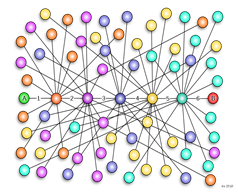The world is even smaller than you thought. Adding a new chapter to the research that cemented the phrase “six degrees of separation” into the language, scientists at Facebook and the University of Milan reported recently that the average number of acquaintances separating any two people in the world was not six but 4.74. The original “six degrees” finding, published in 1967 by the psychologist Stanley Milgram, was drawn from 296 volunteers who were asked to send a message by postcard, through friends and then friends of friends, to a specific person in a Boston suburb. The new research used a slightly bigger cohort: 721 million Facebook users, more than one-tenth of the world’s population. The findings have been posted on Facebook’s site. The experiment took one month. The researchers used a set of algorithms developed at the University of Milan to calculate the average distance between any two people by computing a vast number of sample paths among Facebook users. They found that the average number of links from one arbitrarily selected person to another was 4.74. In the United States, where more than half of people over 13 are on Facebook,  it was just 4.37. However, a Microsoft study in 2008, using a more conservative definition of friend, found an average chain of 6.6 people in a group of 240 million who exchanged chat messages. Eric Horvitz, a Microsoft researcher who led the study in 2008, said that network was based on people who exchanged messages, rather than those who identified as “buddies.” “When considering even the most distant Facebook user in the Siberian tundra or the Peruvian rain forest,” the company wrote on its blog, “a friend of your friend probably knows a friend of their friend.” The caveat there is “Facebook user” — like the Milgram study, the cohort was a self-selected group, in this case people with online access who use a particular Web site. Though the study was by far the largest of its kind, it raised questions about definitions of terms like “friend” on Facebook. Jon Kleinberg, a computer science professor at Cornell and a faculty adviser to an author of the new study, said some links might be more meaningful than others. Matthew O. Jackson, an economist at Stanford who studies social networks, raised questions about the bias built into a study based on random samples. He said the study confirmed Facebook’s success in being where millions of people communicate. “It’s more evidence that they’ve been enormously successful at connecting a large number of people very well,” he said. The research underscores the growing power of the emerging science of social networks, in which scientists study the ways people interact by crunching gigantic sets of Internet data and how it has drawn people more tightly together, for better or worse.
it was just 4.37. However, a Microsoft study in 2008, using a more conservative definition of friend, found an average chain of 6.6 people in a group of 240 million who exchanged chat messages. Eric Horvitz, a Microsoft researcher who led the study in 2008, said that network was based on people who exchanged messages, rather than those who identified as “buddies.” “When considering even the most distant Facebook user in the Siberian tundra or the Peruvian rain forest,” the company wrote on its blog, “a friend of your friend probably knows a friend of their friend.” The caveat there is “Facebook user” — like the Milgram study, the cohort was a self-selected group, in this case people with online access who use a particular Web site. Though the study was by far the largest of its kind, it raised questions about definitions of terms like “friend” on Facebook. Jon Kleinberg, a computer science professor at Cornell and a faculty adviser to an author of the new study, said some links might be more meaningful than others. Matthew O. Jackson, an economist at Stanford who studies social networks, raised questions about the bias built into a study based on random samples. He said the study confirmed Facebook’s success in being where millions of people communicate. “It’s more evidence that they’ve been enormously successful at connecting a large number of people very well,” he said. The research underscores the growing power of the emerging science of social networks, in which scientists study the ways people interact by crunching gigantic sets of Internet data and how it has drawn people more tightly together, for better or worse.
December 14, 2011
Subscribe to:
Post Comments (Atom)


No comments:
Post a Comment